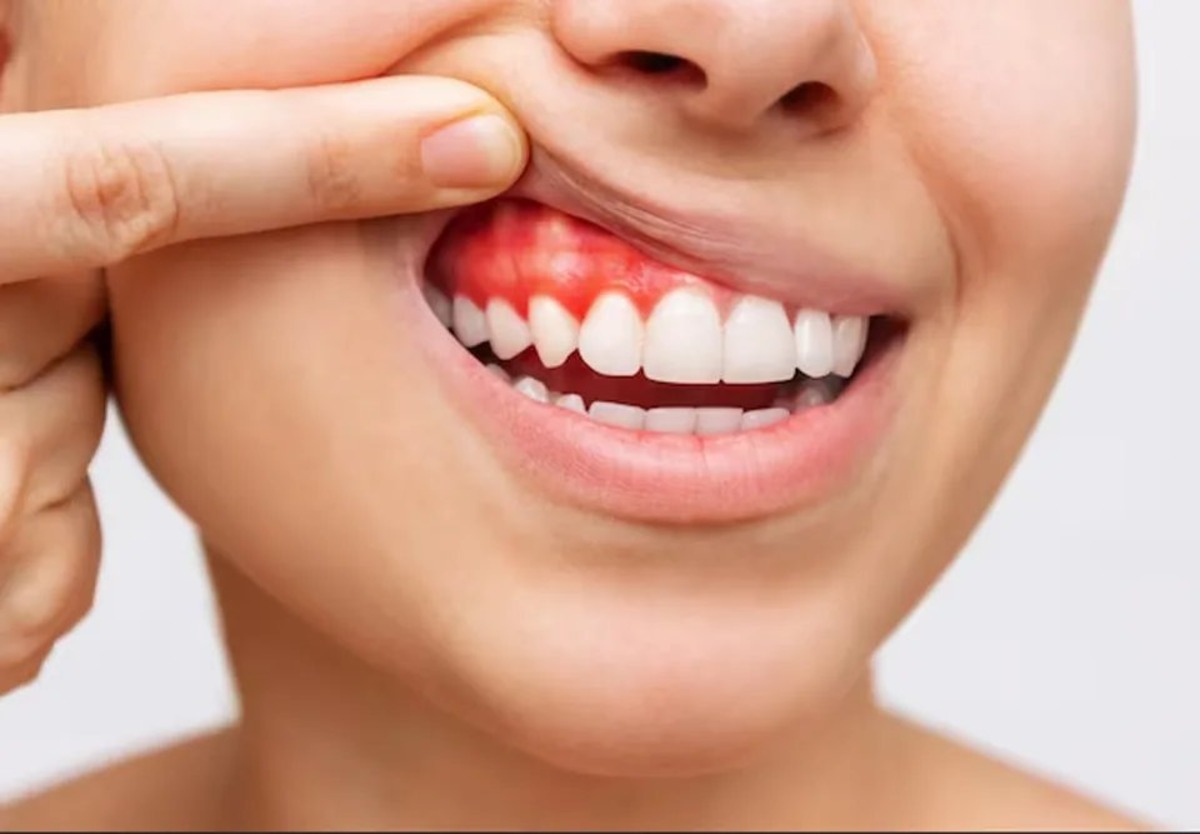Home>Health and Wellness>The Ultimate Guide To Healing Receding Gums


Health and Wellness
The Ultimate Guide To Healing Receding Gums
Published: January 23, 2024
Learn effective strategies for improving your oral health and healing receding gums with our comprehensive guide. Discover expert tips and natural remedies for optimal health and wellness.
(Many of the links in this article redirect to a specific reviewed product. Your purchase of these products through affiliate links helps to generate commission for Noodls.com, at no extra cost. Learn more)
Table of Contents
Introduction
Welcome to the ultimate guide to healing receding gums. In this comprehensive article, we will delve into the essential aspects of receding gums, including understanding the condition, identifying its causes, recognizing signs and symptoms, exploring preventive measures, and discovering natural and professional treatments. Additionally, we will provide valuable dental care tips for maintaining healthy gums.
Receding gums, also known as gingival recession, is a common dental issue that occurs when the gum tissue surrounding the teeth wears away or pulls back, exposing the tooth roots. This condition can lead to increased tooth sensitivity, aesthetic concerns, and potential dental health complications if left untreated. Therefore, it is crucial to have a deep understanding of receding gums and the various ways to address and prevent this issue.
By the end of this guide, you will have a comprehensive understanding of receding gums and the tools to effectively manage and improve gum health. Whether you are seeking natural remedies, professional treatments, or preventive measures, this guide will equip you with the knowledge to make informed decisions about your dental health.
Let's embark on this journey to explore the world of receding gums, empowering ourselves with the knowledge and strategies to achieve optimal gum health.
Understanding Receding Gums
Receding gums, also known as gingival recession, occur when the gum tissue surrounding the teeth wears away or pulls back, leading to the exposure of the tooth roots. This condition can affect individuals of all ages and is a common dental problem that requires attention and care.
The gums play a crucial role in supporting and protecting the teeth. Healthy gum tissue forms a tight seal around the teeth, providing a barrier against bacteria and other harmful substances. However, when the gums recede, the protective barrier is compromised, leaving the tooth roots vulnerable to damage and decay.
Several factors contribute to the development of receding gums. These include aggressive brushing or flossing, periodontal disease, genetic predisposition, hormonal changes, tobacco use, teeth grinding, misaligned teeth, and inadequate dental care. Additionally, age is a significant factor, as the risk of gum recession tends to increase with age.
Understanding the underlying causes of receding gums is essential in addressing the condition effectively. By identifying the specific factors contributing to gum recession, individuals can take proactive steps to mitigate these influences and prevent further gum tissue loss.
It's important to note that receding gums can lead to various oral health issues, such as increased tooth sensitivity, aesthetic concerns, and an elevated risk of tooth decay and gum disease. Moreover, untreated gum recession can ultimately result in tooth loss and compromise overall dental health.
In summary, understanding the nature of receding gums involves recognizing the importance of gum tissue in maintaining dental health, identifying the contributing factors, and acknowledging the potential consequences of untreated gum recession. This understanding forms the foundation for implementing preventive measures and seeking appropriate treatments to address receding gums effectively.
Causes of Receding Gums
Receding gums can be attributed to various factors, each contributing to the gradual erosion of the gum tissue. Understanding the specific causes of gum recession is essential in developing preventive strategies and seeking appropriate treatments. Here are the primary factors that can lead to receding gums:
-
Aggressive Brushing and Flossing: Overly vigorous brushing or flossing can damage the delicate gum tissue, leading to recession over time. Using a hard-bristled toothbrush or applying excessive force while brushing can contribute to gum erosion.
-
Periodontal Disease: Gingivitis and periodontitis, which are forms of gum disease, can cause the gums to recede. These conditions result from bacterial infections that lead to inflammation and damage to the gum tissue and supporting bone structure.
-
Genetic Predisposition: Some individuals may have a genetic predisposition to developing receding gums. Genetic factors can influence the thickness and strength of the gum tissue, impacting its resilience against recession.
-
Hormonal Changes: Hormonal fluctuations, particularly in women, can affect gum health. Hormonal changes during puberty, pregnancy, and menopause can make the gums more susceptible to recession.
-
Tobacco Use: Smoking or using smokeless tobacco can have detrimental effects on gum health. Tobacco use can lead to a decrease in blood flow to the gums, impairing their ability to resist infection and heal from damage.
-
Teeth Grinding: Persistent teeth grinding, also known as bruxism, can exert excessive pressure on the teeth and surrounding gums, potentially causing recession over time.
-
Misaligned Teeth: Irregular tooth positioning or bite alignment issues can create excessive force on specific areas of the gums, leading to localized recession.
-
Inadequate Dental Care: Poor oral hygiene practices, including infrequent brushing and flossing, can contribute to the accumulation of plaque and tartar, increasing the risk of gum disease and recession.
-
Age: As individuals age, the risk of gum recession tends to increase. The natural aging process can lead to gradual changes in the gum tissue, making it more susceptible to recession.
By understanding these underlying causes of receding gums, individuals can take proactive measures to mitigate these factors and preserve their gum health. Additionally, recognizing the role of these factors in gum recession is crucial in seeking appropriate professional treatments and implementing preventive strategies to maintain healthy gums.
Signs and Symptoms of Receding Gums
Identifying the signs and symptoms of receding gums is essential for early detection and prompt intervention. While the condition may initially manifest subtly, paying attention to the following indicators can help individuals recognize potential gum recession:
-
Visible Tooth Roots: One of the primary visual indications of receding gums is the exposure of the tooth roots. As the gum tissue recedes, the lower portion of the teeth becomes more visible, often appearing longer than usual.
-
Increased Tooth Sensitivity: Receding gums can lead to heightened tooth sensitivity, particularly when consuming hot, cold, sweet, or acidic foods and beverages. The exposure of the tooth roots can make the teeth more susceptible to temperature and texture-related discomfort.
-
Bleeding Gums: Gums that bleed easily, especially during brushing or flossing, may indicate the presence of gum recession. The compromised gum tissue is more prone to bleeding, signaling potential underlying issues.
-
Gum Discoloration: Changes in the color of the gums, such as a darker hue or redness, can be a sign of gum recession. Discoloration may indicate inflammation and damage to the gum tissue.
-
Gum Tenderness or Discomfort: Receding gums can cause the affected areas to feel tender or sore. Discomfort may be experienced when touching or applying pressure to the gums.
-
Loose or Shifting Teeth: As the gum tissue recedes and underlying bone structure is compromised, teeth may become loose or shift in position. Changes in tooth alignment can be indicative of advanced gum recession.
-
Changes in Gumline Appearance: An irregular or uneven gumline, where certain areas appear lower or higher than others, may suggest the presence of gum recession.
-
Halitosis (Bad Breath): Persistent bad breath that is not alleviated by oral hygiene practices or mouthwash may be linked to gum recession and the accumulation of bacteria in the exposed tooth roots.
Recognizing these signs and symptoms empowers individuals to seek professional dental evaluation and intervention at the earliest indication of gum recession. Early detection and proactive management can help prevent further tissue loss and mitigate potential complications associated with receding gums.
Preventing Receding Gums
Preventing receding gums involves proactive measures to maintain optimal gum health and minimize the risk of gum recession. By implementing effective preventive strategies, individuals can significantly reduce the likelihood of experiencing gum tissue erosion and its associated complications.
Gentle Oral Hygiene Practices
Adopting gentle oral hygiene practices is fundamental in preventing receding gums. Using a soft-bristled toothbrush and employing a gentle brushing technique can help protect the delicate gum tissue from damage. Additionally, using dental floss with care and avoiding aggressive flossing can contribute to maintaining the integrity of the gums.
Regular Dental Check-ups
Regular dental check-ups are essential for monitoring gum health and addressing any potential issues at an early stage. Dental professionals can detect signs of gum recession and provide guidance on preventive measures tailored to individual needs. Professional cleanings and comprehensive oral examinations play a crucial role in preventing and managing receding gums.
Balanced Diet and Hydration
A balanced diet rich in essential nutrients, particularly vitamin C and calcium, supports gum health and overall oral well-being. Adequate hydration is also vital for maintaining saliva production, which helps cleanse the mouth and protect the gums from bacterial infections. By nourishing the body with a wholesome diet and staying hydrated, individuals can contribute to the prevention of gum recession.
Tobacco Cessation
Quitting smoking and other forms of tobacco use can significantly reduce the risk of gum disease and recession. Tobacco products can impair blood flow to the gums, hinder the healing process, and contribute to oral health complications. By eliminating tobacco use, individuals can promote healthier gums and minimize the likelihood of gum tissue erosion.
Read more: How To Get Gum Out Of Carpet
Stress Management
Effective stress management techniques can indirectly contribute to gum health. Chronic stress and tension can lead to teeth grinding and jaw clenching, which may accelerate gum recession. Engaging in stress-reducing activities, such as meditation, yoga, or deep breathing exercises, can help alleviate tension and reduce the potential impact on gum health.
Customized Oral Care
Individuals with specific dental concerns, such as misaligned teeth or a history of gum disease, should work closely with their dental professionals to develop personalized oral care plans. Customized interventions, such as orthodontic treatments or targeted periodontal therapies, can help address underlying issues and minimize the risk of gum recession.
By embracing these preventive measures and prioritizing gum health, individuals can take proactive steps to prevent receding gums and safeguard their overall oral well-being. Consistent adherence to these strategies, combined with regular dental care, can contribute to the long-term preservation of healthy gums and a confident smile.
Natural Remedies for Receding Gums
In addition to professional treatments, natural remedies can play a supportive role in promoting gum health and potentially addressing mild cases of receding gums. While natural remedies should not replace professional dental care, they can complement existing oral hygiene practices and contribute to overall gum wellness.
Oil Pulling
Oil pulling, an ancient Ayurvedic practice, involves swishing a tablespoon of coconut oil or sesame oil in the mouth for about 15-20 minutes. This technique is believed to help reduce harmful bacteria in the mouth and promote gum health. Regular oil pulling may contribute to maintaining a clean oral environment and supporting gum tissue.
Read more: How To Heal Diastasis Recti
Aloe Vera Gel
Aloe vera, known for its soothing and healing properties, can be applied topically to the gums to alleviate inflammation and promote tissue regeneration. The natural antibacterial and anti-inflammatory properties of aloe vera make it a popular choice for promoting oral health. Using aloe vera gel as a mouthwash or applying it directly to the gums can offer potential benefits for individuals with receding gums.
Green Tea
Green tea contains antioxidants and anti-inflammatory compounds that may support gum health. Regular consumption of green tea can help reduce inflammation and combat bacteria in the mouth, contributing to the overall well-being of the gums. Additionally, the polyphenols present in green tea have been associated with potential protective effects on gum tissue.
Vitamin C-Rich Foods
A diet rich in vitamin C can contribute to the maintenance of healthy gums. Foods such as oranges, strawberries, kiwi, and bell peppers are excellent sources of vitamin C, which plays a crucial role in collagen production and immune function. Adequate vitamin C intake supports the body's natural ability to repair and maintain gum tissue.
Saltwater Rinse
A simple saltwater rinse can help alleviate gum inflammation and promote oral hygiene. Mixing a teaspoon of salt in warm water and rinsing the mouth with this solution can aid in reducing bacteria and soothing irritated gums. Regular saltwater rinses can serve as a cost-effective and accessible natural remedy for individuals with receding gums.
While natural remedies can offer potential benefits for gum health, it is essential to consult with a dental professional before incorporating these approaches, especially for individuals with pre-existing dental conditions or undergoing specific treatments. Integrating natural remedies into a comprehensive oral care routine, under the guidance of a dental professional, can contribute to promoting gum health and supporting overall oral well-being.
Professional Treatments for Receding Gums
Professional treatments for receding gums are essential for addressing advanced cases of gum recession and preventing further tissue loss. Dental professionals offer a range of interventions tailored to individual needs, aiming to restore gum health and preserve the integrity of the oral structures.
-
Scaling and Root Planing: This deep cleaning procedure targets the removal of plaque and tartar from the tooth surfaces and root surfaces below the gumline. By eliminating bacterial deposits and smoothing the root surfaces, scaling and root planing facilitate gum tissue reattachment and reduce the progression of gum recession.
-
Gum Grafting: In cases where significant gum tissue loss has occurred, gum grafting may be recommended to augment the gumline and cover exposed tooth roots. During this procedure, tissue from the patient's palate or a donor source is used to reinforce the receded gums, enhancing their resilience and appearance.
-
Regenerative Procedures: Dental professionals may utilize regenerative techniques to stimulate the regeneration of gum tissue and supporting bone. This may involve the application of biocompatible membranes, bone grafts, or growth factors to encourage the natural healing and reconstruction of the affected areas.
-
Pinhole Surgical Technique (PST): PST is a minimally invasive procedure designed to address gum recession through a series of small incisions and the repositioning of the existing gum tissue. This innovative technique offers a less invasive alternative to traditional gum grafting, promoting rapid healing and minimal post-operative discomfort.
-
Orthodontic Treatment: In cases where misaligned teeth contribute to localized gum recession, orthodontic interventions may be recommended to address the underlying causes. By repositioning the teeth and redistributing the forces exerted on the gums, orthodontic treatment can help mitigate the progression of gum recession.
-
Periodontal Plastic Surgery: Advanced periodontal plastic surgery techniques, such as tunneling or lateral pedicle grafting, can be employed to address complex cases of gum recession. These surgical approaches aim to restore gum tissue volume and contour, enhancing both the aesthetics and functionality of the gums.
-
Ongoing Maintenance and Monitoring: Following professional treatments for receding gums, ongoing maintenance and regular monitoring by dental professionals are crucial. This may include personalized oral hygiene instructions, professional cleanings, and periodic assessments to ensure the long-term stability and health of the treated gums.
By leveraging these professional treatments and interventions, individuals with receding gums can benefit from targeted strategies to address the condition and preserve gum health. Dental professionals play a pivotal role in guiding patients through the treatment process, offering personalized care and effective solutions to mitigate the impact of gum recession.
Dental Care Tips for Healthy Gums
Maintaining healthy gums is vital for overall oral well-being, and adopting effective dental care practices can significantly contribute to gum health. Here are essential tips to promote healthy gums and minimize the risk of gum recession:
Gentle Brushing Technique
Utilize a soft-bristled toothbrush and gentle brushing motions to clean the teeth and gumline. Brushing too vigorously can damage the delicate gum tissue, potentially leading to recession over time. Aim to brush for at least two minutes, covering all tooth surfaces and gently massaging the gums.
Regular Flossing
Incorporate daily flossing into your oral hygiene routine to remove plaque and food debris from between the teeth and along the gumline. Proper flossing helps prevent gum disease and supports gum health by eliminating potential irritants that can contribute to tissue inflammation and recession.
Antimicrobial Mouthwash
Use an antimicrobial mouthwash as part of your daily oral care regimen to reduce bacteria and plaque in the mouth. Antimicrobial mouthwashes can help maintain a clean oral environment and support gum health by minimizing the presence of harmful microorganisms that can contribute to gum disease.
Balanced Diet
Adopt a balanced diet rich in essential nutrients, particularly vitamin C and calcium, to support gum health. Nutrient-dense foods contribute to the body's natural ability to repair and maintain gum tissue, promoting resilience against gum recession and supporting overall oral well-being.
Regular Dental Check-ups
Schedule regular dental examinations and professional cleanings to monitor gum health and address any potential issues promptly. Dental professionals can detect early signs of gum recession and provide personalized guidance to maintain healthy gums, emphasizing the importance of preventive care and early intervention.
Avoid Tobacco Use
Refrain from smoking and using other tobacco products, as they can significantly impact gum health. Tobacco use can impair blood flow to the gums, hinder the healing process, and increase the risk of gum disease and recession. By eliminating tobacco use, individuals can support healthier gums and minimize the likelihood of tissue erosion.
Read more: How To Get Gum Out Of Carpet
Stress Management
Implement stress-reducing techniques to alleviate tension and minimize the potential impact on gum health. Chronic stress and tension can contribute to teeth grinding and jaw clenching, which may accelerate gum recession. Engaging in stress management activities can help support gum health and overall well-being.
By integrating these dental care tips into your daily routine, you can actively promote healthy gums and reduce the risk of gum recession. Consistent adherence to these practices, combined with professional guidance from dental professionals, can contribute to the long-term preservation of optimal gum health.
Conclusion
In conclusion, the journey through the ultimate guide to healing receding gums has provided valuable insights into understanding, preventing, and addressing this common dental concern. Receding gums, or gingival recession, can have far-reaching implications for oral health, impacting not only the aesthetics of the smile but also the integrity of the teeth and supporting structures. By delving into the causes, signs, and preventive measures associated with receding gums, individuals can empower themselves with the knowledge to proactively manage and improve their gum health.
Understanding the multifaceted causes of receding gums, ranging from aggressive oral hygiene practices to genetic predisposition and hormonal influences, underscores the importance of tailored preventive strategies. From adopting gentle brushing techniques and regular flossing to embracing a balanced diet and prioritizing stress management, individuals can take proactive steps to minimize the risk of gum recession and support optimal gum health.
The exploration of natural remedies and professional treatments for receding gums has highlighted the diverse approaches available to address this condition. From oil pulling and aloe vera gel to advanced periodontal plastic surgery and regenerative procedures, individuals have access to a range of interventions tailored to their specific needs. Seeking professional guidance and ongoing monitoring from dental professionals is crucial in navigating the treatment journey and ensuring the long-term stability of gum health.
The significance of effective dental care practices, including gentle brushing, regular flossing, and antimicrobial mouthwash use, cannot be overstated in promoting healthy gums and mitigating the risk of gum recession. Coupled with regular dental check-ups and a commitment to tobacco cessation and stress management, these practices form the cornerstone of comprehensive gum care.
Ultimately, the ultimate guide to healing receding gums serves as a comprehensive resource for individuals seeking to enhance their understanding of this prevalent dental concern and take proactive steps to safeguard their gum health. By embracing the knowledge and strategies outlined in this guide, individuals can embark on a journey towards achieving and maintaining healthy, resilient gums, supporting not only their oral well-being but also their overall quality of life.









